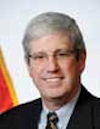Salina Municipal Opts for Preformed Thermoplastic Taxiway Markings
 |
All those mid-continent fuel stops and the constantly changing local climate put SLN's pavement markings through an "extreme amount of wear and tear," explains Timothy Rogers, A.A.E., executive director of the Salina Airport Authority.
A recent $35,000 switch to preformed thermoplastic markings on some taxiways is expected to provide longer-lasting markings that require less maintenance.
Facts & Figures Project: Taxiway Pavement Markings Location: Salina (KS) Municipal Airport Project Cost: $35,172 Engineering Consultant: Bucher, Willis and Ratliff General Contractor: APAC Preformed Thermoplastic Product: AirMark(r) Manufacturer/Supplier: Flint Trading Applicator: AutoIR 816 Infrared Heater, from KM International Project Completed: October 2009 Application Rate: 2,000 sq. ft. in 2 1/2 days Benefits: Longer lifespan, lower long-term maintenance costs
Exploring Alternatives
Currently, SLN is in the midst of a phased rehabilitation of taxiway Alpha and a number of its connecting taxiways. (Alpha runs parallel to the airport's 12,300-foot primary runway.) This major taxiway rehabilitation, combined with the FAA's requirement for enhanced taxiway centerline markings and hold position markings at Part 139 airports by year-end, made it an ideal time to explore alternatives to traditional painted pavement markings.
"We were looking for a way to reduce ongoing maintenance costs for these fairly large and intricate two-color pavement markings," Rogers explains.
Finding a better application method and increasing longevity were also main objectives.
With the help of engineering consultant Bucher, Willis and Ratliff (BWR), the airport considered a number of pavement marking alternatives before settling on preformed thermoplastics.
Comparative Benefits
Because the FAA did not recognize preformed thermoplastics as an approved material in early 2009 (see sidebar), the airport authority had to request permission from the FAA Central Region in writing before applying them.
With BWR's assistance, the authority provided a cost-benefit analysis comparing traditional painted markings with its product of choice, AirMark(r) by Flint Trading. Preformed thermoplastic markings, the written appeal asserted, provide long-term retroreflectivity because glass beads are intermixed throughout the material rather than adhered to the top layers. As the markings wear, new glass beads are exposed and retroreflectivity is maintained.
|
Timothy Rogers |
"The FAA wanted to ensure that this product provided a level of performance and safety equal to or greater than FAA standard pavement marking methods," notes BWR project manager Steve Harris. "For AIP funding, they wanted to make sure they were cost beneficial."
Green Light Approval
After receiving the necessary FAA permission, SLN applied more than 2,000 square feet of preformed thermoplastic markings at 15 taxiway locations in 2 1/2 days.
|
Steve Harris |
|
Chris Brooks |
"These markings go down fast, which minimizes your runway shutdown time," notes Rogers.
To adhere the markings, crews applied a two-part sealer to clean, dry concrete and asphalt surfaces. Next, they rolled the thermoplastic material onto the prepared surface and heated it with variable speed reciprocating infrared equipment. The walk-along heater spans up to 16 feet, but essentially folds in half for smaller applications.
Although the initial cost of purchasing and applying AirMark is higher than traditional painted markings (approximately $16 per square foot vs. $3 to $4 per square foot, respectively), maintenance costs associated with paint applications top out at nearly $30 per square foot over the projected eight-year lifespan of preformed thermoplastic markings, notes Rogers.
Actual long-term savings, he adds, would probably be greater, since the maintenance costs cited above are based on annual repainting. "To maintain good visibility, we estimated that we would likely have to repaint twice a year," he qualifies. "The red fades very quickly, and we also have to make sure we maintain adequate reflective bead adhesion."
Preformed thermoplastic markings, adds Brooks, can be particularly beneficial for airports with limited funding and staffing resources.
 |
FAA Approves New Pavement Marking Material In September 2009, the FAA issued a new Advisory Circular (AC 150/5370-10E) that includes preformed thermoplastic materials for use on taxiway and apron markings. Before revising the former AC (150/5370-10B), FAA tested and evaluated AirMark(r) preformed thermoplastic markings for a year at two locations: Newark Liberty International Airport, which provided approximately 700 aircraft movements per day, and the William J. Hughes Technical Center. Tests compared the material to current paints in terms of retroreflectivity, chromaticity, friction properties and adherence to pavement surface.
So Far, So Good
Despite a very active winter, the taxiway markings applied at SLN in October 2009 are "performing beautifully," reports Rogers. "The markings are immediately visible when thawing occurs. I anticipate they will be durable over a substantial period of time."
Before switching to the non-traditional markings, SLN personnel surveyed preformed thermoplastics at Lambert-St. Louis International. SLN, in turn, invites other airports to inspect its airfield markings.
"It's a good alternative, and I think it's something that's going to be used more widely," says Rogers.
FREE Whitepaper
PAVIX: Proven Winner for All Airport Concrete Infrastructure
International Chem-Crete Corporation (ICC) manufactures and sells PAVIX, a unique line of crystalline waterproofing products that penetrate into the surface of cured concrete to fill and seal pores and capillary voids, creating a long lasting protective zone within the concrete substrate.
Once concrete is treated, water is prevented from penetrating through this protective zone and causing associated damage, such as freeze-thaw cracking, reinforcing steel corrosion, chloride ion penetration, and ASR related cracking.
This white paper discusses how the PAVIX CCC100 technology works and its applications.











